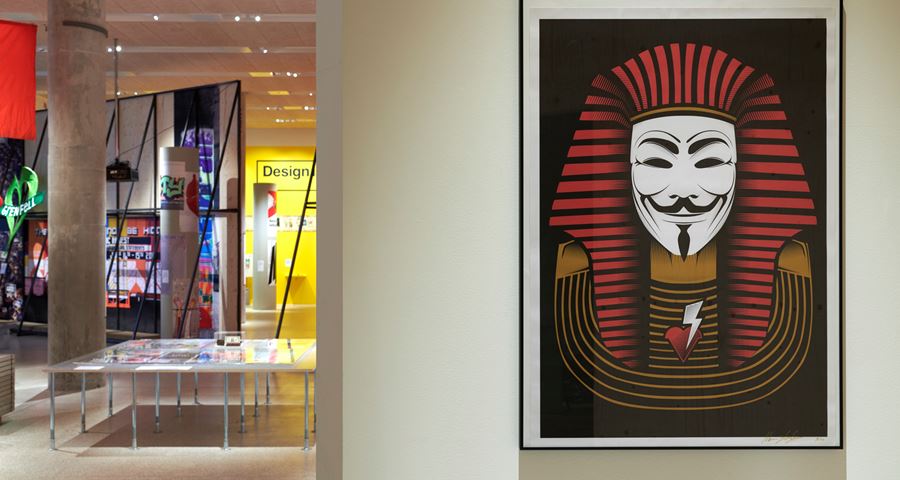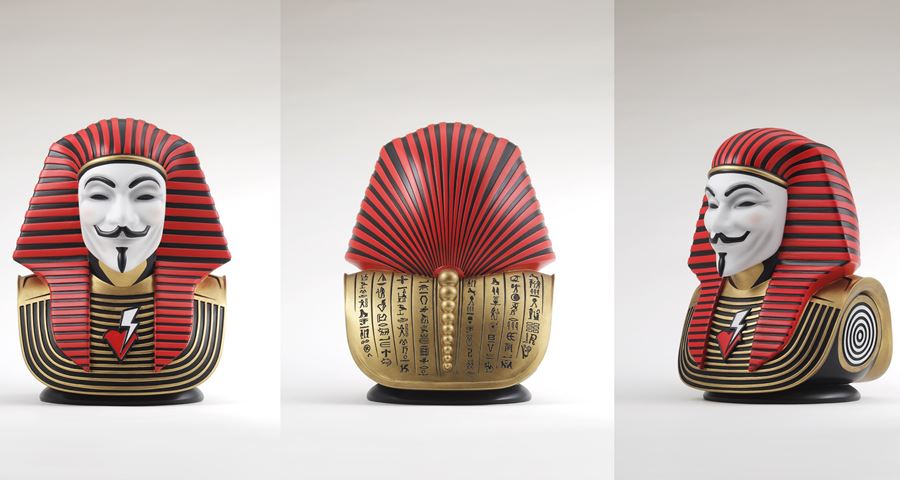Hope to Nope: Graphics and Politics 2008 - 2018
Q&A with Marwan Shahin
To mark the Hope to Nope: Graphics and Politics 2008-2018 exhibition, the Design Museum speaks to Egyptian artist, Marwan Shahin.
Marwan's 2Vth, (Anonymous Pharaoh), which combines the mask used by Anonymous with the pharaoh Tutankhamun, can be found on display inside the Hope to Nope exhibition. This piece of street art was created immediately after protesters forced President Hosni Mubarak from office during the Arab Spring uprisings.
Q:
When did the Anonymous Pharaoh start appearing in the streets of Alexandria, Egypt?
I created the mural right after the uprising on this big grey wall in Alexandria, around mid-February just before the Mubarak regime was taken down, it was really amazing to see how the people started wearing the Guy Fawkes mask during Egypt's protests post 25 January 2011.

Q:
Can you describe what was happening at the time and how it affected you?
It was really life changing. I was born in Egypt during Mubarak’s time in power. The regime was almost like religion, where we didn’t have a choice about it and it was very abusive, corrupted and here to stay. In 2011 after the horrible police brutality cases being widely discussed over social media, young people started protesting against the government which was pretty surreal. After the persistence in Tahrir square and all over Egypt we took down the corrupted regime, which till this day made me truly believe in our ability to accomplish anything no matter how hard or far it seems.
Q:
Given the politically charged nature of your work, have you experienced any obstacles whilst working on or presenting your artwork?
Fortunately no, I understand the risks of doing politically charged work in Egypt so I choose to make subliminal statements with my art without offending the wrong people, which sometimes limits me as a creative artist. I have had many controversial and provocative ideas, which have never seen the light of day. My portrait of Queen Elizabeth reading the Qur’an is just the tip of the iceberg.
Q:
Do you think young people today are more politicised compared to previous generations?
We definitely are. I believe in the age of the new internet, where we are communicating more, becoming more politically aware, more outspoken and more cultured compared with the earlier generations, that's why you see young people shaping modern history everywhere.

Q:
Can you tell us a bit more about how the Walls of Freedom book, which features your Anonymous Pharaoh on the cover, was confiscated?
The authors Basma Hamdy and Don Karl reached out to me to feature the Pharaoh on the cover of the critically acclaimed “Walls of Freedom” book that documented all the street art and graffiti that flooded the streets of Egypt during the revolution. The book itself was banned in Egypt and all the copies coming from Germany got confiscated by the customs, because they said that the book was "instigating revolt" as it contained imagery confronting the police and armed forces at that time.
Q:
Can you explain the reason why you combined the mask used by Anonymous with the pharaoh Tutankhamun?
I wanted to create an iconic representation of the young people’s Egyptian revolution. The Guy Fawkes mask holds so much power, its the perfect imagery for revolting. I chose to mash that with Tutankhamun because he was a young pharaoh who died at the age of 19, just like a lot of young Egyptian kids who sadly lost their lives too early in the events of the uprising in 2011. Later I decided to take off his crown as I wanted him to represent the people not the king. This started the cycle of mashing elements from different realms and cultures, which is definitely an important key to my design language.
Q:
You are influenced by the way Ancient Egyptians documented events through their imagery. How have you interpreted Ancient Egyptian murals and paintings into your contemporary work and what was the decision behind combining the old with the new?
I wanted to do what ancient Egyptians were doing 7000 years ago, which is to tell and document their history through imagery and art. I've been researching ancient Egyptian murals and paintings and their design system so I can create my own interpretation of it. In my new body of work I’ve drawn from archival photos of the revolution to assure accuracy. I've created these multi-layered pieces, deep in hidden messages telling events and facts that actually happened in the Egyptian uprising in 2011. The reason why I approached this concept is because as an Egyptian artist I always felt that Egypt's rich ancient culture in art, design and architecture hasn't been properly referenced or built upon in contemporary Egypt or in the modern world. I want to change that. I want the work I’m doing to be looked at in a few thousand years from now the same way we’re looking at Ancient Egyptian artefacts today.
Q:
Why do you think street-art is such a powerful tool for political expression in Egypt?
I believe street art is a powerful tool anywhere in the world, as it can change climates, face oppression and help get your message straight to the people. You saw how the influence of the “Hope” poster by Shepard Fairey changed the course of the world for 8 years, that has always amazed me.
Q:
Can you tell us a little bit more about your “BANNED" art series discussing women’s rights in the Middle East? Do you see any gradual change in gender equality in the region?
It started in 2012 with “Born to Ride” a piece featuring a girl wearing a full niqab (black burka) breaking the law in her country, risking her freedom and life by taking her gold-studded Harley bike for a revolutionary ride while the police are hot on her tail. That piece birthed my "BANNED" series discussing women’s lack of rights in the Middle East. While I was working on my work, which featured women in niqab doing things they’re not allowed to do like riding a motorcycle, going to the cinema, participating in sports or even playing in a rock band, I started to see some hope and change. For instance, Saudi Arabia have recently allowed women to drive and have lifted the cinema ban, which lasted for 35 years.

Q:
The Hope to Nope exhibition is a retrospective of the last ten years in politics and graphic design. Which event do you remember the most from the past decade, which has left the most impact on you and do you remember where you were at the time?
Definitely the Arab Spring, and specifically the Egyptian Revolution. As I proudly took part in it, I remember being on the streets of Alexandria along with millions that day Mubarak resigned. The protests turned into celebrations and it just made me believe so much in ourselves as Egyptians and the underestimated power of the people’s voice. Governments work for us not the other way around.
Q:
What’s the one thing you’d like people to remember about your artwork when they leave the Hope to Nope exhibition?
I want them to feel that they witnessed a piece of modern Egyptian history.
Q:
Finally, if you had one piece of advice for a young artist who had a story to tell, what would it be?
My advice is to believe in yourself, believe in your power as a human being, believe in your art no matter the consequences and let your art tell the story.
Find out more